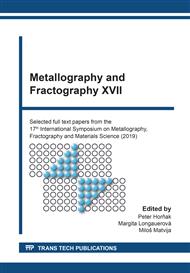p.217
p.223
p.229
p.234
p.240
p.245
p.251
p.259
p.264
Defects of Steel Sheets Joined by Laser Welding
Abstract:
Introduction of new technologies demands a new access to quality evaluation of products. Joining of steel sheets with laser butt welding requires increased demand on precision of welded sheet ends alignment as well as condition of cutting edge. Moreover, increased requirements are placed on purity of environment, flatness of strips, gases, etc. The paper deals with evaluation of quality of laser butt welds of steel sheets and description of defects which could occur on welds from the metallographic point of view. The influence of relative displacement of welded strips ends alignment, different relative sheet thickness alignment, welding gap size and quality of sheet shear edge on quality of weld will be described. The most significant effect on quality of weld joints and their final mechanical properties has relative position of strip ends and geometry of cutting edge.
Info:
Periodical:
Pages:
240-244
Citation:
Online since:
November 2020
Keywords:
Price:
Сopyright:
© 2020 Trans Tech Publications Ltd. All Rights Reserved
Share:
Citation:


